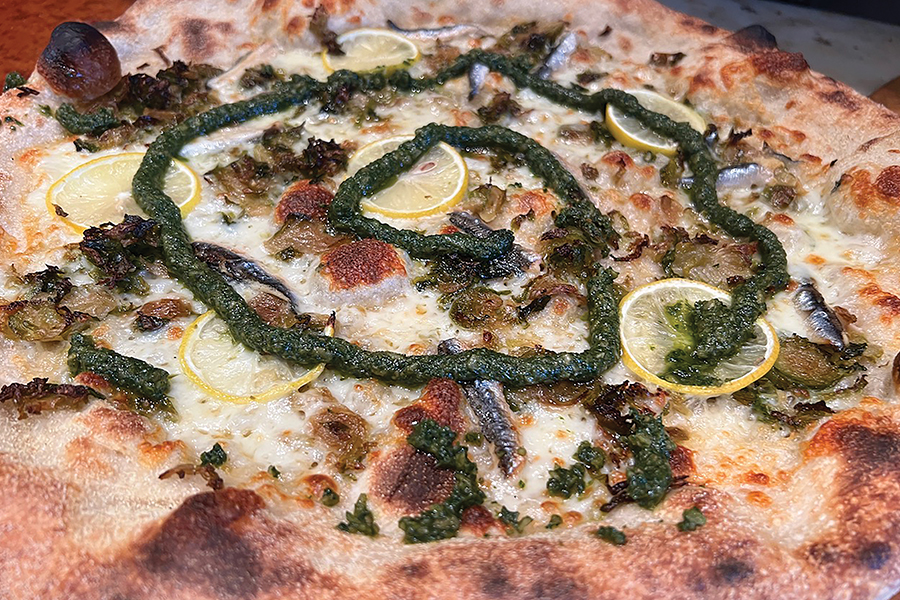Magical Pesto
Pesto is one of those magic pizza toppings that can turn the most basic pie into something really special. The classic recipe is comprised of just a few ingredients but there’s no limit to putting your own unique spin on it.
While most people associate pesto with the basil and garlic heavy version, there are quite a few traditional variations depending on what region of Italy you are in. The celebrated, and extremely delicious, pesto that is comprised of pine nuts, basil, garlic, Parmigiana Reggiano, Pecorino and extra virgin olive oil originated in Genoa in the province of Liguria. To truly make this in the Genoese way, a mortar and pestle are required. In Calabria, pesto all Calabrese consists of roasted bell peppers, garlic, black pepper, basil, cheese and olive oil. Sicily’s version is very similar but with the addition of tomatoes. Other countries have their takes on pesto such as in France you have Pistou, which is a combination of basil, parsley, crushed garlic and grated cheese. Spain makes Romesco, which is a red paste of Romesco chili peppers blended with tomatoes, sweet red peppers, pine nuts, garlic and olive oil.
Six Components to Pesto
Regardless of what type you are making, there are six components to any pesto:
Greens and herbs: Basil is the most common, but you can add or sub anything from cilantro to arugula to kale and even throw in some chives or mint. Of course, you can add other vegetables and fruits that aren’t green such as tomatoes and bell peppers.
Cheese: Traditionally aged, hard cheeses like Parmigiano-Reggiano or Grana Padano are used as they have a sharp, salty flavor. But you can also use other cheeses such as Cotija, Manchego or aged Cheddar. If you want to do a vegan version there are a lot of nut cheeses out there or you can forgo the cheese entirely and add in a squeeze of lemon and an extra pinch of salt to balance it out.
Nuts or seeds: There are so many options when it comes to this component. Pine nuts are delicious but they are very pricey so a few other great options are walnuts, cashews, pumpkin seeds, sunflower seeds and pistachios. You can enhance the flavor by toasting the nuts or seeds before adding them to the pesto.
Oil: I’m a purest when it comes to oil and almost always lean towards a good quality extra virgin olive oil. That’s not to say there aren’t other great oils out there and each has its own use.
Garlic: This is a big one and a very distinct flavor of pesto. That’s not to say you can’t substitute it for another plant in the Allium family. Spring garlic, leeks, green onions and chives will make for an interesting pesto depending on what you pair it with.
Salt and other seasonings: As with every other pizza or dish you make, the correct salt is essential. If you’re using a saltier cheese, you won’t need very much, if any at all, but don’t forget to taste the finished product.
Non-Traditional Pesto Ideas
After you’ve made your ideal pesto it’s time to put it on a pizza. Pesto is one of those toppings that go great with both veggies and meat. You can add it separately onto the pizza or use it as a marinade for other toppings such as chicken, pork, onions, kale or even a white fish or shrimp. Here are a few ideas to get you started
- Sun-dried tomato pesto with artichoke hearts, feta, Kalamata olives and red onion.
- Sunflower seed and lemon basil pesto with roasted fennel, Italian sausage and sweet onion.
- Arugula pesto with anchovies, thinly sliced lemon and breadcrumbs
- Cilantro pumpkin seed pesto with poblano chilies, Cotija, delicate squash and leeks.
- Roasted red pepper pesto with eggplant, zucchini and sweet onions.
- Pistachio pesto with mortadella and burrata.
The application of pesto is an essential part of the pizza — how and when you add it to your pie. If you put it on pre-bake you can either use it as the base of the pizza, use a squeeze bottle or pastry bag to drizzle it on or dollop it on top with a spoon. If you use it as the sauce on the base, I would recommend making the pesto itself thinner by adding more oil or even a bit of water so it’s easier to spread. The other option is to add the pesto post bake, which is my current favorite way. Putting the pesto on after it comes out of the oven is visually more appealing as it keeps its vibrant color. A squeeze bottle is also quicker and for the most part you get a better yield on the product.
Pesto is very versatile. Not only is it fantastic on pizza but it can and should be cross utilized throughout your menu. Don’t hesitate to make it into a side dish, think burrata with pesto and toasted focaccia. It can be thinned out into a dressing mixed with seasonal veggies or used as a pasta sauce option. You can marinate chicken or beef in it for toppings or something as simple as a dipping sauce.
Try this pesto pizza recipe.
Go Fish
This recipe features anchovies, Brussels sprouts, lemon and an arugula pesto.
Audrey Kelly owns Audrey Jane’s Pizza Garage in Boulder, Colorado.







